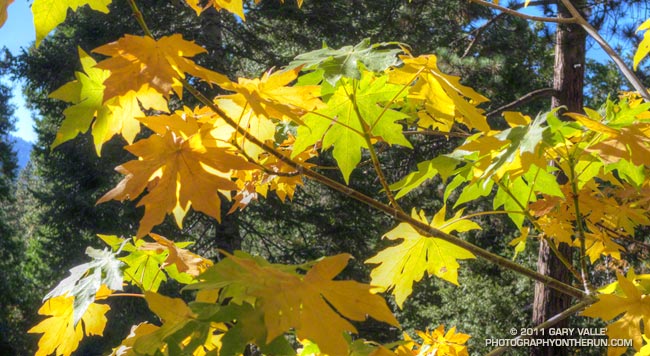
From Saturday’s Falls Creek loop on Mt. San Gorgonio.

From Saturday’s Falls Creek loop on Mt. San Gorgonio.
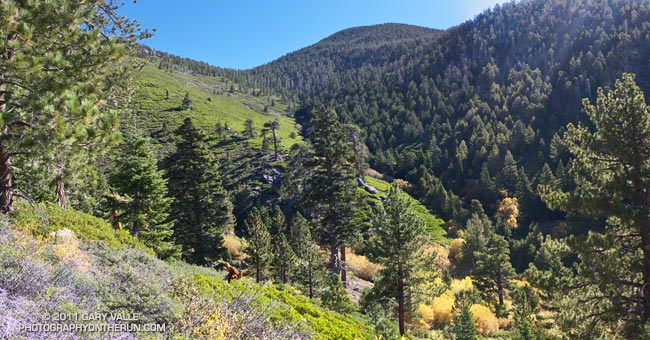
I don’t say this very often, but it was great to be running on pavement — smooth, even, consistent pavement. All I had to do was put one foot in front of the other and chug on down the blacktop.
I was running down Valley of the Falls Drive from the Vivian Creek trailhead to the Momyer Creek trailhead after ascending San Gorgonio Mountain (11,499′). San Gorgonio is the highest peak in Southern California, the nearest higher peaks being Charleston Peak (11,916′) west of Las Vegas, and Olancha Peak (12,123′) in the Sierra Nevada.
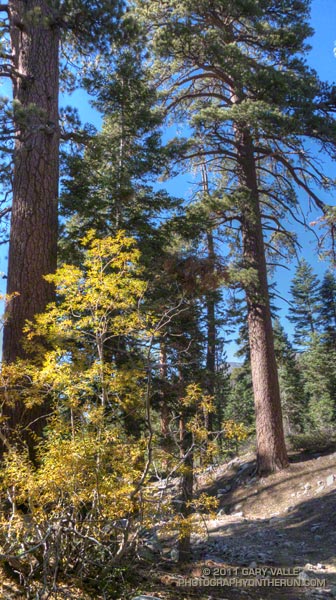
The Momyer Creek and Vivian Creek trailheads are in Mill Creek Canyon, near Forest Falls, on the south side of San Gorgonio Mountain. It only takes me a few minutes longer to drive to the Momyer Trailhead than to drive to Islip Saddle in the San Gabriels, or the Chula Vista trailhead on Mt. Pinos. Momyer is another great option for a scenic, challenging, higher altitude trail run that’s relatively close to home.
There are two routes I like to do on the Forest Falls side of the mountain — the High Line and the Falls Creek loops. Both start/end at Momyer and descend via the Vivian Creek Trail.
Today I’d done the Falls Creek route. This adventurous run features 24 miles of mostly technical trail that gains and loses about 6600′ and tops out at 11,499′. It’s comparable in effort and time to a tough SoCal style 50K. The High Line route is even more of a challenge.
The day had been one of those perfect, cloudless, crystalline days you get in the Autumn, with hundred mile visibility, empyrean blue skies, rich yellow leaves, and long cold shadows.
Following last Winter’s good snowfall and runoff, and the unseasonably strong storm earlier this month, springs and streams were flowing well. On the way I stopped for water at Plummer Meadows, and on the way down at High Creek. Even though I’ve been doing adventures in the mountains for decades, it’s still a little surprising how much water is needed on a higher altitude run, especially when the humidity is low.
Recently someone asked me what kind of water filter I use with a hydration pack. I’ve used three approaches for water treatment when the water source is a “good” one and treatment is a precaution.
Updated September 19, 2017
– UV light pen. SteriPen appears to be the most widely used outdoor UV water purifying pen, and several versions are available. I’m currently using the Steripen Adventurer.
– Inline filter. Before UV pens were widely available and accepted I would occasionally use an inline filter. When dry, the filter was lightweight, however its flow rate was barely adequate. The brand I used to use is no longer available, but the Sawyer 3 Way Water Filter looks similar. Specs say it weighs 1.8 oz.
– No treatment. This is the lightest and fastest option, but having watched a climbing friend fight giardia for a year and lose a shocking amount of weight and strength, I can’t recommend it.
In the Wikipedia overview of portable water purification a writer comments that “studies have shown that UV doses at the levels provided by common portable UV units are effective at killing Giardia and that there was no evidence of repair and reactivation of the cysts.”
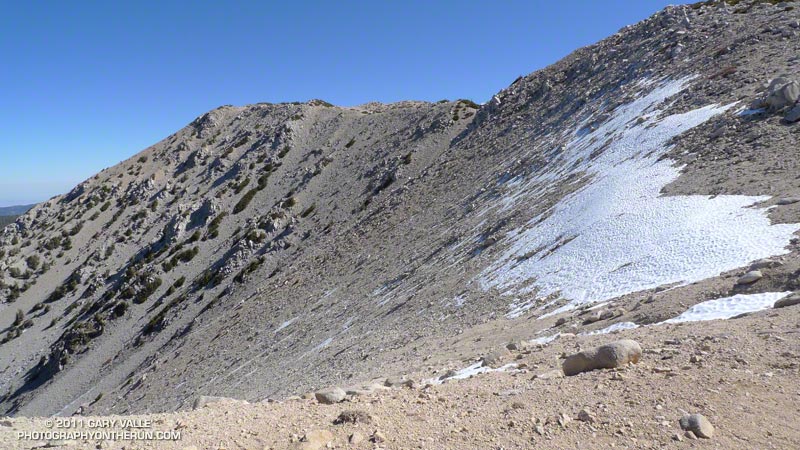
The range of temperatures on today’s run was extraordinary. It was cool on the summit — in the low forties — but the coldest temperature was on the shaded slopes below Dollar Lake Saddle (10,000′). Here the temperature had been a chilly thirty-something. Down in Mill Creek Canyon at the end of the run the temperature felt like it was in the mid-eighties. The Mill Creek RAWS, near the ranger station, recorded a temperature of 92 degrees in the mid afternoon with a relative humidity of only 12%.
One of the highlights of today’s run is that there were still patches of snow above 10,000′ from the storm on October 5th! One big patch at 11,000′ was beginning to become sun-cupped. I don’t think I’ve seen sun-cupped new snow in Autumn before!
The title photograph is from the Falls Creek Trail near Plummer Meadows. Dollar Lake Saddle and Charlton Peak loom above.
Some related posts: San Gorgonio High Line 2009, San Gorgonio Mountain – Falls Creek Loop
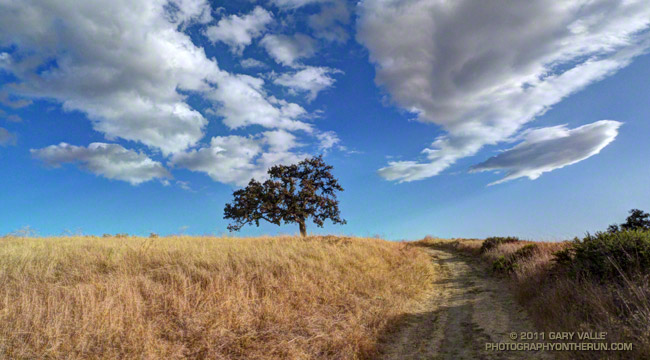
What a difference a week makes! Last week an unseasonably deep upper level low, unusually strong 170+ kt Pacific jet, and associated cold front combined to produce record-setting rainfall and cool temperatures in Southern California. This week high pressure and a weak offshore flow produced triple digit temperatures in some areas and set new high temperature records Wednesday in Downtown Los Angeles, Long Beach and Santa Barbara.
Which pattern is more likely this rain season? Will Southern California tend to be drier like this week, or wetter like last week and last year? Despite last year’s wet rain season, wet La Nina Winters are not the norm. Generally, La Nina conditions result in drier than normal rain seasons in Southern California, and El Nino wetter.
Following a Summer respite La Nina conditions have reemerged in the equatorial Pacific, and appear to be consolidating. Equatorial SST anomalies have continued to decrease and now range from -1.5°C at 100°W to -0.5°C at 170°E. Equatorial Pacific temperature cross sections show substantial subsurface cooling from July 11 to September 11. The Multivariate ENSO Index (MEI) has dropped from -0.5 for July/August to -0.8 for the August/September season. This drops the MEI from a rank of 16th for July/August to 13th for August/September since 1950. This is well within La Nina territory but weaker than last year’s rank of 1st for August/September.
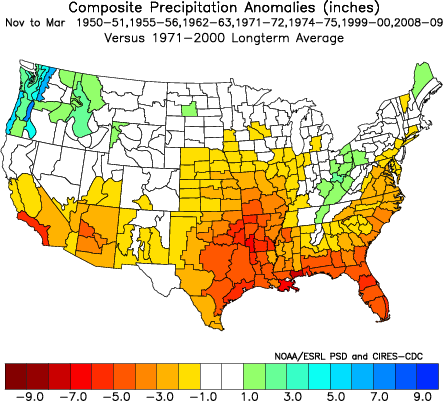
A precipitation composite for seven years* since 1950 in which La Nina conditions persisted or reemerged in the year following a first year La Nina indicates that “on average” the coastal Southern California climate division recorded about 5 to 6 inches less precipitation than normal for the period November through March. The percent of normal water year rainfall recorded at Downtown Los Angeles (USC) ranged from a low of 47% (1971, 7.17″), to a high of 106% (1955, 16.00″). The average rainfall for these years was 70.5%, or 10.7″.
We’ll get the official NOAA/CPC outlooks next week around October 20, when CPC’s Three-Month Precipitation Outlooks and NOAA Winter Outlook are expected to be released.
*The years included in the selection were 1950-51, 1955-56, 1962-63, 1971-72, 1974-75, 1999-2000 and 2008-09. The base period was 1971-2000. The selection was based on the MEI.
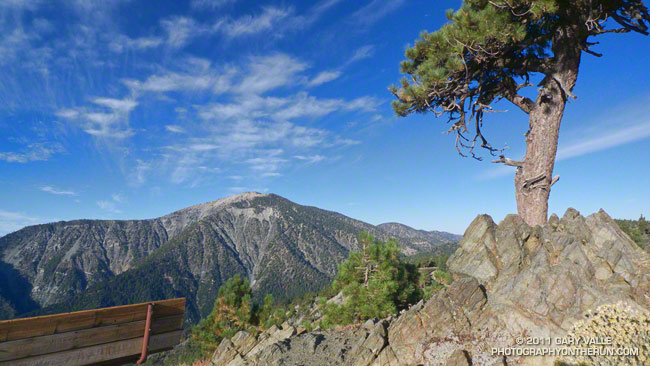
The viewpoint above is a few hundred yards up the Pacific Crest Trail from Angeles Crest Highway at Inspiration Point. Craig and I had paused near the start of our trail run from Inspiration Point to Islip Saddle to check out the view.
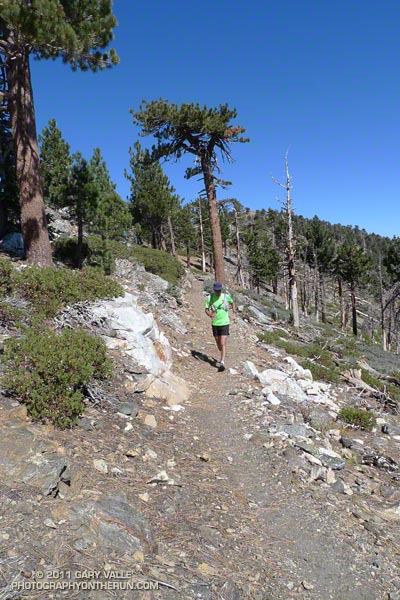
The mountain across the way is Mt. Baden-Powell (9,399′). Three miles away as the bird flies, our earthbound route along Blue Ridge, down to Vincent Gap, and then up the forty-something switchbacks to the top of the peak would total around nine miles. From the top of the peak it would be about eight miles to Islip Saddle.
Zooming in on the peak, the white arrow marks the location of the Wally Waldron Limber Pine. For more than a millennia this grand tree has stood high on this mountain, resisting the strongest of winds and the most perfect of storms. Not all are so durable. A limber pine feet away from the Wally Waldron tree was toppled in a storm last Winter.
Given the short-sleeve weather, the most unexpected discovery on today’s run was ice under the trees just up the ridge from the Wally Waldron tree. The ice had been deposited on the trees a few days before, when an unseasonably strong storm set a new rainfall record for the date in Los Angeles.
The running on the PCT between Mt. Baden-Powell and Islip Saddle was outstanding and the views superb. Along the way we did the short climb to the top of Throop Peak, checked out the Mt. Hawkins Lightning Tree, and enjoyed the cold spring water at Little Jimmy Spring.
Some related posts: Perils of Winter, Surprises of Summer; Wally Waldron Limber Pine; PCT from Inspiration Point to Islip Saddle
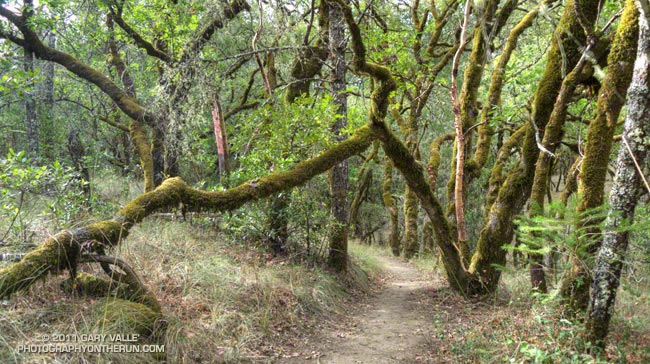
The Coyote Peak Trail in Bothe-Napa Valley State Park near its junction with the Redwood Trail.